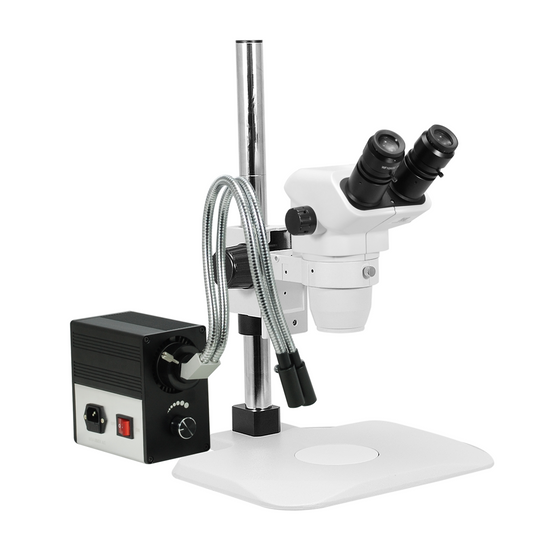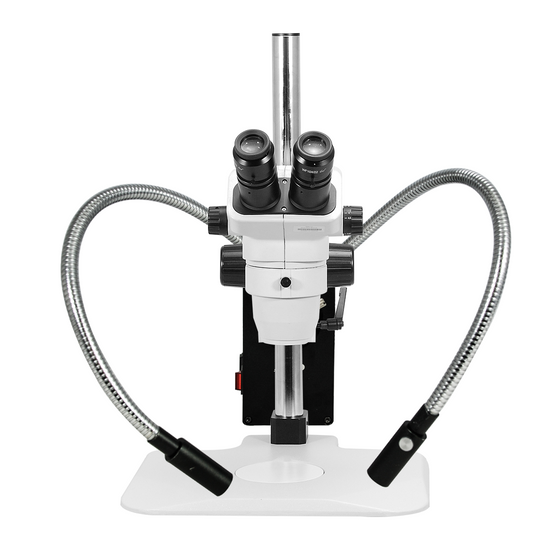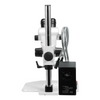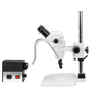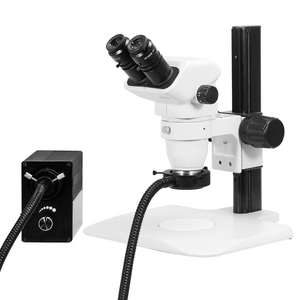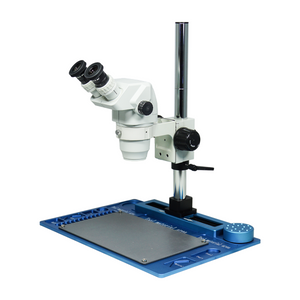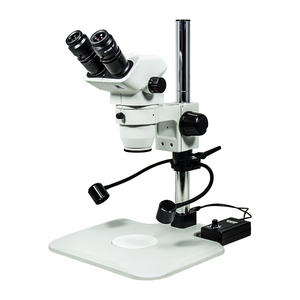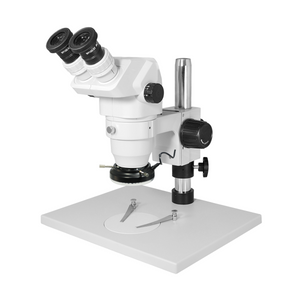Quick Overview
Finite. Total Magnification: 6.7-45X. 10X Adjustable Eyepiece. 1X Built-in Objective. Zoom Ratio: 1:6.7. Binocular. Body Mounting Size for Stand: Dia. 76mm. Eye Tube Angle: 45°. Eyepiece Field of View: Dia. 22mm. Post Stand. UV FREE LED Light. Light Adjustable. Gooseneck Dual Pipe Light . Input Voltage: AC 96-265V 50/60Hz.
SZ02060224 Binocular Zoom Stereo Microscope
Optical System Specifications
| Optical System | Finite |
| System Optical Magnification | 6.7-45X |
| Expandable System Optical Magnification (Optional Parts Required) | 2-180X |
| Total Magnification | 6.7-45X |
| Standard Eyepiece | 10X Adjustable Eyepiece |
| Standard Objective | 1X Built-in Objective |
| System Field of View | Dia. 4.9-32.8mm |
| Expandable System Field of View | Dia. 1.33-109.5mm |
| System Working Distance | 100mm |
| Expandable System Working Distance | 26-287mm |
Binocular Zoom Body
| Body Optical System | Finite |
| Body Magnification | 6.7-45X |
| Zoom Range | 0.67-4.5X |
| Zoom Ratio | 1:6.7 |
| Zoom Operating Mode | With Two Horizontal Knobs |
| Observation Method | Binocular |
| Body Mounting Size for Stand | Dia. 76mm |
| Nosepiece Adapter Size for Ring Light | Dia. 54mm |
| Eye Tube Adjustment Mode | Compensating |
| Eye Tube Angle | 45° |
| Erect/Inverted Image | Erect image |
| Eye Tube Rotatable | 360° Degree Rotatable |
| Interpupillary Adjustment | 54-75mm |
| Eye Tube Inner Diameter | Dia. 30mm |
| Eye Tube Fixing Mode | Locking Screw |
| Eyepiece Type | Adjustable Eyepiece |
| Eyepiece Optical Magnification | 10X |
| Plan Eyepiece | Plan Eyepiece |
| Eyepiece Size for Eye Tube | Dia. 30mm |
| Eyepiece Field of View | Dia. 22mm |
| Eyepoint Type | High Eyepoint Eyepiece |
| Eyepiece Diopter Correction | ±5° |
| Built-in Objective Magnification | 1X |
| Objective Working Distance | 100mm |
| Objective Screw Thread | M48x0.75mm |
| Surface Treatment | Spray Paint |
| Material | Metal |
| Color | White |
| Net Weight | 1.54kg (3.40lbs) |
Post Stand
| 76mm Post Stand | |
| Stand Type | Post Stand |
| Holder Adapter Type | Dia. 76mm Scope Holder |
| Vertical Post Height | 305mm |
| Maximum Vertical Post Extended Length | 150mm |
| Vertical Post Diameter | Dia. 32mm |
| Base Type | Table Base |
| Base Shape | Rectangle |
| Base Mounting Size | M29x1.5-6h |
| Base Dimensions | 320x305x16mm |
| Focus Mode | Manual |
| Focus Distance | 50mm |
| Coarse Focus Distance per Rotation | 21mm |
| Focusing Knob Tightness Adjustable | Tightness Adjustable |
| Center Distance from Hole to Scope Holder | 150mm |
| Surface Treatment | Plastic Spray Coating |
| Material | Metal |
| Color | White |
| Net Weight | 3.25kg (7.17lbs) |
| Dimensions | 320x305x474mm (12.598x12.008x18.661 in. ) |
Microscope Plate
| 95x5mm Black White Plate | |
| Plate Type | Black White Plate |
| Plate Size | Dia. 95x5mm |
| Material | Plastic (ABS) |
| Color | Black, White |
| Applied Field | For ST0201, ST0501, ST1901, ST0801, ST0802 Series Post Stand. ST0203, ST0204 ST0403 Series Track Stand |
Fiber Optic Light Source
| 24W UV Free LED Fiber Optic Illuminator | |
| Light Source Type | UV FREE LED Light |
| Power Supply Adjustable | Light Adjustable |
| Power Box Light Port | Single Hole |
| Fiber Cable Adapter Size | 5/8 in. End Adapter |
| Power Box Panel Meter Display | Pointer Panel Meter/Scale |
| Power Box Cooling System | Fan Cooling system |
| Power Box Dimensions | 185x150x95mm |
| Bulb Color (Wavelength) | UV FREE |
| Output Power | 24W |
| Input Voltage | AC 96-265V 50/60Hz |
| Output Voltage | DC 24V |
| Power Cord Connector Type | USA 3 Pins |
| Surface Treatment | Black Oxide Finish |
| Material | Metal |
| Color | Black |
| Net Weight | 3.20kg (7.05lbs) |
Optical Fiber Light Guide
| 460mm Dual Pipe Light Guide | |
| Optical Fiber Cable Type | Gooseneck Dual Pipe Light |
| Fiber Light Output Port Size | Dia. 5mm |
| Fiber Cable Output Port Adapter Size | Dia. 8mm |
| Fiber Light Input Port Size | Dia. 7mm |
| Fiber Cable Input Port Adapter Size | 5/8 in. End Adapter |
| Pipe Material | Gooseneck Fiber Cable |
| Optical Fiber Cable Length | 460mm |
| Pipe Diameter | Dia. 12.4mm |
| Pipe Color | Silver |
| Flexural Property | Min. Bending Radius ≥30D |
| Fiber Cable Mounting Type | Fastening Screw |
| Fiber Condenser Light Spot Adjustable | Adjustable |
| Material | Metal |
| Color | Silver |
| Net Weight | 0.60kg (1.32lbs) |
Other Parameters
| Surface Treatment | Spray Paint |
| Material | Corrugated Carton |
| Color | White |
| Net Weight | 8.60kg (18.73lbs) |
| Dimensions | 320x305x474mm (12.598x12.008x18.661 in. ) |
Series
| SZ0502 | SZ02060224 |
Technical Info
Instructions
Stereo MicroscopeClose Λ
| Stereo microscopes are also known as the anatomical microscopes, or dissecting microscopes. Many people would refer to stereo microscope as Stereo, and the Continuous Zoom Microscope as Zoom. Stereo microscopes are a kind of binocular microscope that observes an object with both eyes from different angles, thereby causing a stereoscopic effect. The stereo microscope adopts two independent optical paths, and the left and right beams in the binocular tube have a certain angle, generally 12°~15°. The objects are observed from different angles of the two optical paths, causing a three-dimensional effect on the eyes, and therefore a stereo microscope is a true 3D microscope. Compared with other compound microscopes, stereo microscopes belong to the low power optical microscope. The field of view of stereo microscopes has a large diameter, its magnification is generally below 200X for optical magnification. When the magnification is greater than 40X, the stereoscopic effect of the image will be relatively poor. Therefore, the advantage of the stereo microscope is not that its magnification is large, but that its working distance is long and the depth of field is large, which is particularly suitable for observing objects with a high degree of three-dimensional features. For compound microscope with a single optical path, what we see is only a flat image. Although most compound microscopes have two eyepieces, what we actually see is one and the same image, and this is just to facilitate the observation habits of our two eyes. The stereo microscope has two optical paths (two objective lenses or one common objective lens), and only the three-dimensional sense produced under observation of the two optical paths can make people judge the three-dimensional spatial position of the observed object, which can generate a sense of distance under the microscope. Therefore, only stereo microscope can be used for operation under the microscope which is very suitable for surgery, dissection, industrial welding, assembly, precision instrument repair and so on. The stereo microscope can be equipped with a wide range of accessories. It can be combined with various digital cameras and photographic interfaces, microscope cameras, eyepiece cameras and image analysis software to form a digital imaging system. It can be connected to a computer for analysis and processing, and its lighting system also has different options for illumination, such as reflected light, transmitted light, etc. Stereoscopic microscopes are widely used in various fields, such as biology, medicine, agriculture, forestry, marine life, and other various departments. They are especially used in industry, for macroscopic surface observation, analysis, and microscopic operations. Stereoscopic microscopes were invented by American instrument engineer Horatio S. Greenough in the 1890s, manufactured by Carl Zeiss Company of Germany, and are widely used in scientific research, archaeological exploration, industrial quality control, biopharmaceuticals, and more. Stereo Microscope Quick Operation Steps Step 1 In the working position, place the microscope on the workbench after installation. Connect the power source, and turn on the light source. Place an observation sample (also known as specimen) such as a coin etc. under the microscope or on the base. Adjust the focus knob of the stand by visually measuring the height, or based on the working distance parameters of the objective lens used. Step 2 Adjust the zoom knob of the microscope to the lowest magnification. Find the approximate image by adjusting the focus knob. Find a certain feature point of the sample in approximately the center position. Align the feature point of the specimen and gradually adjust to a large magnification. Adjust the lift set of the microscope to find the focal plane of the highest magnification. During the adjustment process, use a sample with obvious feature points (such as a coin) to compare the sharpness of the image. Turn the zoom knob again to the lowest magnification. It is possible that the image may be out of focus. At this time, do not adjust the focusing knob. Simply adjust the diopters on the two eyepieces to accommodate differences in eye observations (diopter varies from person to person). Adjust the viewing distance of the eyepiece to achieve a comfortable position. At this point, the microscope is already parfocal, i.e., when the microscope is changed from high power to low power, the entire image is in the focal plane. To observe the same sample, it is not necessary to adjust other parts of the microscope. Only the zoom knob is needed to zoom in on the specimen for observation. Step 3 Adjust the light source, including the brightness and angle of incidence to get the best image or see additional details. Step 4 Adjust any other necessary equipment such as the photographic eyepieces, cameras, etc., to show the image on the display or to find the sharpest image. When using binocular observation and the left and right images or sharpness is not the same, first adjust the diopter adjustment on the eyepiece. This adjusts the parallax of the two eyes, so that the image of the two eyes are consistent. It is normal to feel viewing fatigue when using a microscope for a long time. Take a break before working again to adapt your eyes to using the microscope. If the microscope is used for too long, or if there is a problem inside the microscope due to large temperature difference, vibration, etc., please contact your dealer or our service staff on the BoliOptics website. |
FiniteClose Λ
| Microscopes and components have two types of optical path design structures. One type is finite optical structural design, in which light passing through the objective lens is directed at the intermediate image plane (located in the front focal plane of the eyepiece) and converges at that point. The finite structure is an integrated design, with a compact structure, and it is a kind of economical microscope. Another type is infinite optical structural design, in which the light between the tube lens after passing the objective lens becomes "parallel light". Within this distance, various kinds of optical components necessary such as beam splitters or optical filters call be added, and at the same time, this kind of design has better imaging results. As the design is modular, it is also called modular microscope. The modular structure facilitates the addition of different imaging and lighting accessories in the middle of the system as required. The main components of infinite and finite, especially objective lens, are usually not interchangeable for use, and even if they can be imaged, the image quality will also have some defects. The separative two-objective lens structure of the dual-light path of stereo microscope (SZ/FS microscope) is also known as Greenough. Parallel optical microscope uses a parallel structure (PZ microscope), which is different from the separative two-object lens structure, and because its objective lens is one and the same, it is therefore also known as the CMO common main objective. |
System Optical MagnificationClose Λ
| The magnification of the objective lens refers to the lateral magnification, it is the ratio of the image to the real size after the original image is magnified by the instrument. This multiple refers to the length or width of the magnified object. System optical magnification is the product of the eyepiece and the objective lens (objective lens zoom set) of the optical imaging part within the system. Optical magnification = eyepiece multiple X objective lens/objective lens set The maximum optical magnification of the microscope depends on the wavelength of the light to which the object is illuminated. The size of the object that can be observed must be greater than the wavelength of the light. Otherwise, the light cannot be reflected or transmitted, or recognized by the human eye. The shortest wavelength of ultraviolet light is 0.2 microns, so the resolution of the optical microscope in the visible range does not exceed 0.2 microns, or 200 nanometers. This size is converted to the magnification of the microscope, and it is the optical magnification of 2000X. Usually, the compound microscope can achieve 100X objective lens, the eyepiece is 20X, and the magnification can reach 2000X. If it is bigger, it will be called "invalid magnification", that is, the image is large, but the resolution is no longer increased, and no more details and information can be seen. |
Total MagnificationClose Λ
| Total magnification is the magnification of the observed object finally obtained by the instrument. This magnification is often the product of the optical magnification and the electronic magnification. When it is only optically magnified, the total magnification will be the optical magnification. Total magnification = optical magnification X electronic magnification Total magnification = (objective X photo eyepiece) X (display size / camera sensor target ) |
System Field of ViewClose Λ
| Field of View, is also called FOV. The field of view, or FOV, refers to the size of the object plane (i.e., the plane of the point of the observed object perpendicular to the optical axis), or of its conjugate plane (i.e., object to primary image distance), represented by a line value. System field of view is the size of the actual diameter of the image of the terminal display device of the instrument, such as the size of the image in the eyepiece or in the display. Field of view number refers to the diameter of the field diaphragm of the objective lens, or the diameter of the image plane formed by the field diaphragm. Field of view number of objective lens = field of view number of eyepiece / (objective magnification / mechanical tube length) Large field of view makes it easy to observe the full view and more range of the observed object, but the field of view (FOV) is inversely proportional to the magnification and inversely proportional to the resolution, that is, the larger the field of view, the smaller the magnification, and also the lower the resolution of the object to be observed. There are usually two ways to increase the field of view, one is to replace with an objective lens of a smaller multiple, or to replace with an eyepiece of a smaller multiple. |
System Working DistanceClose Λ
| Working distance, also referred to as WD, is usually the vertical distance from the foremost surface end of the objective lens of the microscope to the surface of the observed object. When the working distance or WD is large, the space between the objective lens and the object to be observed is also large, which can facilitate operation and the use of corresponding lighting conditions. In general, system working distance is the working distance of the objective lens. When some other equipment, such as a light source etc., is used below the objective lens, the working distance (i.e., space) will become smaller. Working distance or WD is related to the design of the working distance of the objective lens. Generally speaking, the bigger the magnification of the objective lens, the smaller the working distance. Conversely, the smaller the magnification of the objective lens, the greater the working distance. When it is necessary to change the working distance requirement, it can be realized by changing the magnification of the objective lens. |
Binocular Zoom BodyClose Λ
| Binocular zoom body is the main body of a stereo microscope that has continuous zooming functions and observes with two eyepieces. This body usually needs to be placed on a microscope stand for use. Generally, a variety of eyepieces and objective lenses with different magnifications can be selected. A high-end stereo microscope usually has a wide range of accessories for selection. |
Zoom RangeClose Λ
| Zoom in zoom microscope means to obtain different magnifications by changing the focal length of the objective lens within a certain range through adjustment of some lens or lens set while not changing the position of the object plane (that is, the plane of the point of the observed object perpendicular to the optical axis) and the image plane (that is, the plane of the image imaging focus and perpendicular to the optical axis) of the microscope. Zoom range refers to the range in which the magnification is from low to high. In the zoom range of the microscope, there is no need to adjust the microscope knob for focusing, and ensure that the image is always clear during the entire zoom process. The larger the zoom range, the stronger the adaptability of the range for microscope observation, but the image effects at both ends of the low and high magnification should be taken into consideration, the larger the zoom range, the more difficult to design and manufacture, and the higher the cost will be. |
Zoom RatioClose Λ
| Zoom ratio is the ratio of the maximum magnification / the minimum magnification. Expressed as 1: (ratio of maximum magnification / minimum magnification). If the maximum magnification is 4.5X, the minimum magnification is 0.7X, then the zoom ratio = 4.5 / 0.7 = 6.4, the zoom ratio will be 1:6.4. Zoom ratio is obtained by the intermediate magnification group of the microscope. When the magnification is increased or decreased by using other objective lenses, the zoom ratio does not change accordingly. |
With Two Horizontal KnobsClose Λ
| When microscope body changes the magnification, it is realized by adjusting the horizontally placed zoom knob. Because the knob is relatively small, it is therefore easier to zoom and the image is stable. For most of the dual stereo microscopes, magnification is realized by adjusting the zoom drum or nosepiece below. When the nosepiece is relatively big, frequent operation is more laborious. Magnifying while observing, the microscope may shake, thereby causing eye discomfort for observation. Using zoom drum or nosepiece type microscope, if there is a ring light under the microscope, the ring light carries the wire, and when magnification conversion is often required, the ring light and the wire will swing along with the magnification, which makes the operation inconvenient. This situation will not occur to zoom with two horizontal knobs. |
CompensatingClose Λ
| For compensating eyetube, when changing the interpupillary distance, it requires two hands to operate at the same time, with one hand fixing one eyepiece tube, and the other pushing or pulling the other, or both the left and the right hand pushing the two eyetubes at the same time, and changing the position of any one of the eyetube at will. |
Eye Tube AngleClose Λ
| Usually the Microscope Eyetube is 45°, some is 30°, Tiltable Eyetube Angle design of a microscope is also known as the ergonomics microscope. 0-30° or 0-45° is an ergonomic design. When the mechanical tube length / focal length of the tube of the microscope is relatively big, the microscope is relatively high, and the user's height or the seat of the work desk is not suitable, long-term use of microscope may cause sitting discomfort. Eyepiece tube with variable angle can freely adjust the angle without lowering the head. Especially when it is close to 0 degree and the human eye is close to horizontal viewing, long-time or long-term use can avoid fatigue damage to the cervical vertebra. |
Erect/Inverted ImageClose Λ
| After imaging through a set of objective lenses, the object observed and the image seen by the human eye is inverted. When the observed object is manipulated, move the specimen or object, the image will move in the opposite direction in the field of view. Most of the biological microscopes are reversed-phase designs. When needing to operate works with accurate direction, it is necessary to design it into a forward microscope. Generally stereo microscopes and metallurgical microscopes are all of erect image design. When observing through the camera and display, the erect and inverted image can be changed by the orientation of the camera. |
360° Degree RotatableClose Λ
| The eyepiece of the microscope can have different viewing or observing directions. When the position of the microscope is uncomfortable, the direction of the eyepiece tube of the microscope can be adjusted, to facilitate observation and operation. Placement method of different viewing angles of the microscope: General direction: the support column is behind the object to be observed Reverse direction: the support column is in front of the object to be observed Lateral direction: the support column is on the side of the object to be observed Rotating eyepiece tube, different microscopes may have different methods, for some, the direction is confirmed when installing the eyepiece tube of the microscope, for some, by rotating the body of the microscope, and for some, by rotating the support member on the support or holder of the microscope. |
Interpupillary AdjustmentClose Λ
| The distance between the two pupils of the human eye is different. When the image of exit pupil of the two eyepieces of the microscope are not aligned with the entry pupil of the eye, the two eyes will see different images, which can cause discomfort. Adjust the distance between the two eyepieces, to accommodate or adapt to the pupil distance of the observer's eyes. The adjustment range is generally between 55-75mm. |
Adjustable EyepieceClose Λ
| The adjustable eyepiece is between the lens of the eyepiece and the focal plane, with distance adjustable device. For most people, their two eyes, the left and the right, have different vision. For adjustable eyepieces, the eyepoint height of the eyepiece can be adjusted to compensate for the difference in vision between the two eyes, making the image in the two eyes clear and consistent. The range of adjustment of the general eyepiece is that the diopter is plus or minus 5 degrees, and the maximum difference between the two eyepieces can reach 10 degrees. Before use, it is generally necessary to adjust both eyepieces to the initial position where the scale is displayed as 0, which is used as a baseline to facilitate up and down adjustment. The reticle position of the eyepiece is generally 10mm below the fixed position of the eyepiece tube. Because the vision of each person is different, some people may not be able to see the reticle clearly. For adjustable eyepiece, the height of the reticle position can be adjusted to make the reticle and the observed object clear at the same time, this is the advantage of adjustable eyepiece that mounts the diopter adjustment on the eyepiece tube compared with non-adjustable eyepiece. When non-adjustable eyepiece is equipped with a reticle, if the diopter is adjusted, the reticle will rotate accordingly, thereby affecting the position of the measurement. For adjustable eyepiece, when its diopter is adjusted, its reticle does not rotate. |
Eyepiece Optical MagnificationClose Λ
| Eyepiece optical magnification is the visual magnification of the virtual image after initial imaging through the eyepiece. When the human eye observes through the eyepiece, the ratio of the tangent of the angle of view of the image and the tangent of the angle of view of the human eye when viewing or observing the object directly at the reference viewing distance is usually calculated according to 250 mm/focal length of eyepiece. The standard configuration of a general microscope is a 10X eyepiece. Usually, the magnification of the eyepiece of compound microscope is 5X, 8X, 10X, 12.5X, 16X, 20X. As stereo microscope has a low total magnification, its eyepiece magnification generally does not use 5X, but can achieve 25X, 30X and other much bigger magnification. |
Eyepiece Field of ViewClose Λ
| The eyepiece field of view is the diameter of the field diaphragm of the eyepiece, or the diameter of the image plane of the field diaphragm imaged by the field diaphragm. The diameter of a large field of view can increase the viewing range, and see more detail in the field of view. However, if the field of view is too large, the spherical aberration and distortion around the eyepiece will increase, and the stray light around the field of view will affect the imaging effect. |
Eyepoint TypeClose Λ
| Eye point refers to the axial distance between the upper end of the metal frame of the eyepiece and the exit of pupil. The exit of pupil distance of high eyepoint eyepiece is farther than that of the eye lens of the ordinary eyepiece. When this distance is greater than or equal to 18mm, it is a high eyepoint eyepiece. When observing, one does not need to be too close to the eyepiece lens, making it comfort to observe, and it can also be viewed with glasses. Generally, there is a glasses logo on the eyepiece, indicating that it is a high eyepoint eyepiece. |
Built-in Objective MagnificationClose Λ
| The objective of a stereo microscope is mostly built-in objective, which is usually mounted in the microscope body, and it is one or a set of lenses closest to the object to be observed. When not marked, the built-in objective is 1X. |
Objective Working DistanceClose Λ
| The objective working distance is the vertical distance from the foremost surface end of the objective of the microscope to the object surface to be observed. Generally, the greater the magnification, the higher the resolution of the objective, and the smaller the working distance, the smaller the field of view. Conversely, the smaller the magnification, the lower the resolution of the objective, and the greater the working distance, and greater the field of view. High-magnification objectives (such as 80X and 100X objectives) have a very short working distance. Be very careful when focusing for observation. Generally, it is after the objective is in position, the axial limit protection is locked, then the objective is moved away from the direction of the observed object. The relatively greater working distance leaves a relatively large space between the objective and the object to be observed. It is suitable for under microscope operation, and it is also easier to use more illumination methods. The defect is that it may reduce the numerical aperture of the objective, thereby reducing the resolution. |
Objective Screw ThreadClose Λ
| For microscopes of different manufacturers and different models, the thread size of their objectives may also be different. In general, the objective threads are available in two standard sizes, allowing similar objectives between different manufacturers to be used interchangeably. One is the British system: RMS type objective thread: 4/5in X 1/36in, One is metric: M25 X 0.75mm thread. |
Post StandClose Λ
| Post stand generally has relatively tall post. When the focus is adjusted, the focusing mechanism can slide up and down the post, the microscope is thus placed in an approximately focused position, and then the focusing mechanism makes fine and accurate adjustment. This kind of stand can move quickly, and is suitable for viewing objects with a higher height and bigger volume. After the microscope is mounted, the microscope imaging center needs to be aligned with the center of the platen. The focusing mechanism button on the post must be tightened to lock the guard ring device, and the microscope should be prevented from loosening and shaking when working. When it is necessary to adjust the height, hold the microscope and the focusing mechanism with one hand, then release the knob, adjust it to the proper position, lock the knob, then top the guard ring to the lower position of the focusing mechanism, and lock it tight. In particular, avoid accidental dropping of the microscope due to gravity, thereby damaging the microscope and the objects below. |
Dia. 76mm Scope HolderClose Λ
| The 76mm stand scope holder is the most popular microscope body adapter size, suitable for stereo microscopes produced by most manufacturers. Place the microscope body in a 76mm scope holder, tighten with screws to avoid shaking when the microscope is in use. Because this stand scope holder is very common, some special-sized microscopes can also borrow and use this stand, but only need a specific adapter to connect the microscope body with a diameter of less than 76mm. |
Focusing Knob Tightness AdjustableClose Λ
| Different microscope bodies, different human operations, and different requirements for observation and operation, all require adjustment of the pre-tightening force of the stand that support microscope body. Facing the stand just right, use both hands to reverse the force to adjust the tightness. (face the knob of one side just right, clockwise is to tighten, counterclockwise is to loosen) In general, after long-time use, the knob will be loose, and adjustment is necessary. |
Microscope PlateClose Λ
| According to different objects to be observed, the appropriate platen should be selected. The microscope plate materials include black and white, black and white finish; transparent glass, frosted glass, metal, etc. Standard stands are generally configured with a suitable microscope plate, but different plates may need to be purchased separately. Black and white microscope plate are made of general plastics, and the different backgrounds in black and white make the object more prominent. Finish microscope plate eliminates reflections during observation. Transparent glass plate is used when observing transparent or translucent objects, and the use of transmitted light source is to make the light penetrate the object to be observed as much as possible. Finish glass plate, with its rough glass surface, can make the transmitted light more uniform and create a diffusing effect, avoiding exposure of the light shadow of the filament directly onto to the observed object. Metal plate, relatively more solid, is more suitable when it is necessary to operate and cut. Microscope plate is generally round shaped, on one side of the base there is a spring clip. When installing, align the plate with the clamp and push it in, and then press down the other end, so that the plate is smoothly embedded in to the circular card slot of the bottom plate. When removing, grab the other end of the clip, push and lift up the plate. |
Fiber Optic Light SourceClose Λ
| Fiber optic light source refers to an illuminating light source that does not contain or contains less spectrum of infrared heat radiation in a illuminating or light guiding body, for example, the popular LED light source, which is a typical illuminator fiber optic light source. In microscopic illumination, the optical fiber cold light source (commonly referred to as “cool light”) means that, after the illumination beam is transmitted through the optical fiber of the light guide body, the heat radiation is not brought to the light exit port, thereby achieving "cold light" effect. The portion of the illuminating light source of the optical fiber has been conventionally illuminated with a halogen light source. In recent years, high-power LED lighting has been widely used. Although the bulb of halogen light source can generate a lot of heat radiation, because of its high brightness when emitting light, it belongs to full-band light, with good color reproduction and comfortable observation by human eye, and therefore is still irreplaceable in some applications. Luminous light sources usually require a high-power light source to achieve strong light, therefore heat dissipation is very important. Whether it is a halogen light source or an LED light source, fan cooling is usually adopted. Fiber optic lighting application has many advantages: 1. The thermal conductivity of the optical fiber is poor. When the light source (light bulb) emits light, the thermal radiation, after being separated by the optical fiber, is not transmitted to the object to be observed. So, while maintaining the wavelength and brightness of the light, it becomes "cold light". When using strong light, cold light may not damage the observed objects, especially in medical and biological applications. 2. Single light source can be transmitted through the optical fiber, and at the same time there are multiple light-emitting points with the same light-emitting characteristics. The light-emitting port can be arranged at different positions and angles, or made into different shapes, such as double-branch lighting, ring lighting, multi-point lighting etc. 3. The light source host and the light exit port illumination point are transmitted through the optical fiber, and therefore the host can be placed in a safe or suitable position without affecting the illumination position of the light exit port, so that there will be more flexibility in design and use. 4. The light exiting port illumination point is transmitted through the optical fiber, and it can filter freely the wavelength of the light at the light source position in the front end of the light entrance, increase the polarization effect, and adjust the brightness and darkness. For example, improve the contrast and contrast ratio of the details of the object to be observed through various color filters, filter out the ultraviolet and infrared light, and reduce damage to certain items.. 5. In the light source host and optical fiber used in fiber optic lighting, the service life of the optical fiber can be decades, and the design separating the light source from the optical fiber makes the light source easy to repair and replace. |
Light AdjustableClose Λ
| The brightness of the light source adjustable is very important in the imaging of the microscope. Since the difference of the numerical aperture of the objective lens of high magnification and low magnification is very big, more incident light is needed to achieve a much better resolution when using a high magnification objective lens. Therefore, when observing through a high magnification objective lens, the brightness required is high; when observing through a low magnification objective lens, the brightness required is low. When observing different objects, or feature points of the same object at different positions, the brightness needs are also different; including the difference of background light or reflection within the field of view of observation, it has a great influence on the effect of observing the object, and therefore one needs to adjust the brightness of the light source according to each object to be observed. In the light source capable of providing continuous spectrum, such as a halogen lamp, the brightness adjustment of the light not only adjusts the brightness and intensity of the light, but also changes the spectrum emitted by the light source. When the light source is dark, there are many components of red light, and when the brightness is high, there are more blue spectrum. If the required light is strong and the spectrum needs to be changed, the light can be kept at a brighter intensity, which is solved by adjusting the spectrum by adding a color filter. Take note of the dimming button on the light source, after the On/Off switch is turned on, normally clockwise is to brighten, and counterclockwise is to darken. If it is adjusted to the lowest brightness, the light source should normally be lit. If the naked eye still can't see the object being illuminated brightly, you need to adjust the brightness knob to a much bigger position. Generally, there is scale marking on the dimming knob, which is an imaginary number representing the percentage of brightness, or an electronic digital display, giving the brightness of the light source under the same conditions a marking. |
Optical Fiber Light GuideClose Λ
| Optical fiber bundle for illumination, is referred to as optical fiber light guide for short. Optical fiber light guide is a fiber core made of transparent material (typically, glass fiber is made of silicon dioxide). Around the fiber core, a cladding layer is formed, using a material having a refractive index lower than that of the fiber core, that is, if the refractive index of the fiber core and the cladding layer are n1 and n2, then n1 must be >n2. The transmission of the optical fiber makes use of the principle of total reflection of light. In this fiber core medium, light is to maintain its characteristics of optical waveform for transmission, wherein the fiber core portion of high refractive index is the main channel for light transmission, while the outer casing of low refractive index covers the entire fiber core. Since the core has a higher refractive index than the outer casing, total reflection occurs, and therefore light can be transmitted in the fiber core. The core of the optical fiber is generally classified into glass fiber, quartz fiber, plastic fiber, and liquid core fiber etc. Microscope illumination usually uses glass fiber, which can have better transmittance for light of different wavelengths. For glass fiber, its optical core material is multi-component optical glass with high refractive index, whereas its cladding material is optical glass with low refractive index. The commonly used multi-component glass formula include: sodium-borosilicate glass (Na-B-Si), potassium-borosilicate glass (K-B-Si), sodium-zinc aluminoborosilicate glass (Na-Zn-Al-B-Si), and the like. Glass fiber, made of optical glass, has a much higher transparency than a ordinary set of glass, but still has a relatively high attenuation value, generally about 1dB/m. The lighting fiber optic wire is very thin, and cannot be bent at a large angle. Generally, its minimum bending radius ≥30D (Min. bending radius ≥30D). Check the breaking of the fiber optic wire, you can use one side section to face the light, and the other side section to see the dark part. If there is too much break, it can’t be repaired, but the entire fiber be replaced. |
PackagingClose Λ
| After unpacking, carefully inspect the various random accessories and parts in the package to avoid omissions. In order to save space and ensure safety of components, some components will be placed outside the inner packaging box, so be careful of their inspection. For special packaging, it is generally after opening the box, all packaging boxes, protective foam, plastic bags should be kept for a period of time. If there is a problem during the return period, you can return or exchange the original. After the return period (usually 10-30 days, according to the manufacturer’s Instruction of Terms of Service), these packaging boxes may be disposed of if there is no problem. |
Optical Data
| Microscope Optical Data Sheet | ||||||||||||||
| P/N | Objective | Objective Working Distance | Eyepiece | |||||||||||
| SZ05021121 (10X Dia. 22mm) | SZ05023421 (15X Dia. 16mm) | SZ17013421 (15X Dia. 16mm) | SZ05023621 (20X Dia. 12mm) | SZ17013621 (20X Dia. 12.5mm) | SZ05023821 (30X Dia. 8mm) | |||||||||
| Magnification | Field of View(mm) | Magnification | Field of View(mm) | Magnification | Field of View(mm) | Magnification | Field of View(mm) | Magnification | Field of View(mm) | Magnification | Field of View(mm) | |||
| SZ05014111 | 0.3X | 287mm | 2.01-13.5X | 16.3-109.45mm | 3.02-20.25X | 11.85-79.6mm | 3.02-20.25X | 11.85-79.6mm | 4.02-27X | 8.89-59.7mm | 4.02-27X | 9.26-62.19mm | 6.03-40.5X | 5.93-39.8mm |
| SZ05014121 | 0.4X | 217mm | 2.68-18X | 12.22-82.09mm | 4.02-27X | 8.89-59.7mm | 4.02-27X | 8.89-59.7mm | 5.36-36X | 6.67-44.78mm | 5.36-36X | 6.94-46.64mm | 8.04-54X | 4.44-29.85mm |
| SZ19024211 | 0.5X | 177mm | 3.35-22.5X | 9.78-65.67mm | 5.03-33.75X | 7.11-47.76mm | 5.03-33.75X | 7.11-47.76mm | 6.7-45X | 5.33-35.82mm | 6.7-45X | 5.56-37.31mm | 10.05-67.5X | 3.56-23.88mm |
| SZ05014311 | 0.7X | 120mm | 4.69-31.5X | 6.98-46.91mm | 7.03-47.25X | 5.08-34.12mm | 7.03-47.25X | 5.08-34.12mm | 9.38-63X | 3.81-25.59mm | 9.38-63X | 3.97-26.65mm | 14.07-94.5X | 2.54-17.06mm |
| SZ05021121 | 1X | 100mm | 6.7-45X | 4.89-32.84mm | 10.05-67.5X | 3.56-23.88mm | 10.05-67.5X | 3.56-23.88mm | 13.4-90X | 2.67-17.91mm | 13.4-90X | 2.78-18.66mm | 20.1-135X | 1.78-11.94mm |
| SZ05014511 | 1.5X | 47mm | 10.05-67.5X | 3.26-21.89mm | 15.08-101.25X | 2.37-15.92mm | 15.08-101.25X | 2.37-15.92mm | 20.1-135X | 1.78-11.94mm | 20.1-135X | 1.85-12.44mm | 30.15-202.5X | 1.19-7.96mm |
| SZ05014611 | 2X | 26mm | 13.4-90X | 2.44-16.42mm | 20.1-135X | 1.78-11.94mm | 20.1-135X | 1.78-11.94mm | 26.8-180X | 1.33-8.96mm | 26.8-180X | 1.39-9.33mm | 40.2-270X | 0.89-5.97mm |
| 1. Magnification=Objective Optical Magnification * Body Magnification * Eyepiece Optical Magnification | ||||||||||||||
| 2. Field of View=Eyepiece Field of View /(Objective Optical Magnification*Body Magnification) | ||||||||||||||
| 3. The Darker background items are Standard items, the white background items are optional items. | ||||||||||||||
| Contains | ||||||||||||||||
| Parts Including | ||||||||||||||||
| ||||||||||||||||
| Packing | |
| Packaging Type | Carton Packaging |
| Packaging Material | Corrugated Carton |
| Packaging Dimensions(1) | 36x20x27cm (14.173x7.874x10.630″) |
| Packaging Dimensions(2) | 38x36x19cm (14.961x14.173x7.480″) |
| Packaging Dimensions(3) | 25.5x15.5x25.5cm (10.039x6.102x10.039″) |
| Packaging Dimensions(4) | 23x22.5x4cm (9.055x8.858x1.575″) |
| Inner Packing Material | Plastic Bag |
| Ancillary Packaging Materials | Expanded Polystyrene |
| Gross Weight | 10.34kg (22.80lbs) |
| Minimum Packaging Quantity | 1pc |
| Transportation Carton | Carton Packaging |
| Transportation Carton Material | Corrugated Carton |
| Transportation Carton Dimensions(1) | 36x20x27cm (14.173x7.874x10.630″) |
| Transportation Carton Dimensions(2) | 38x36x19cm (14.961x14.173x7.480″) |
| Transportation Carton Dimensions(3) | 25.5x15.5x25.5cm (10.039x6.102x10.039″) |
| Transportation Carton Dimensions(4) | 23x22.5x4cm (9.055x8.858x1.575″) |
| Total Gross Weight of Transportation(kilogram) | 10.34 |
| Total Gross Weight of Transportation(pound) | 22.80 |
| Quantity of One Transportation Carton | 4pc |


